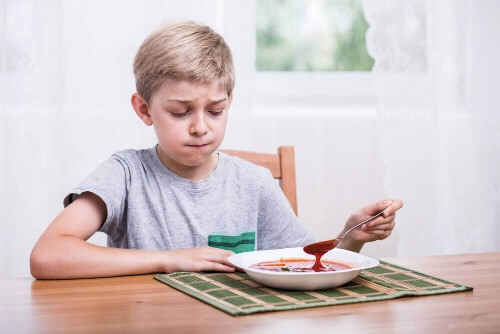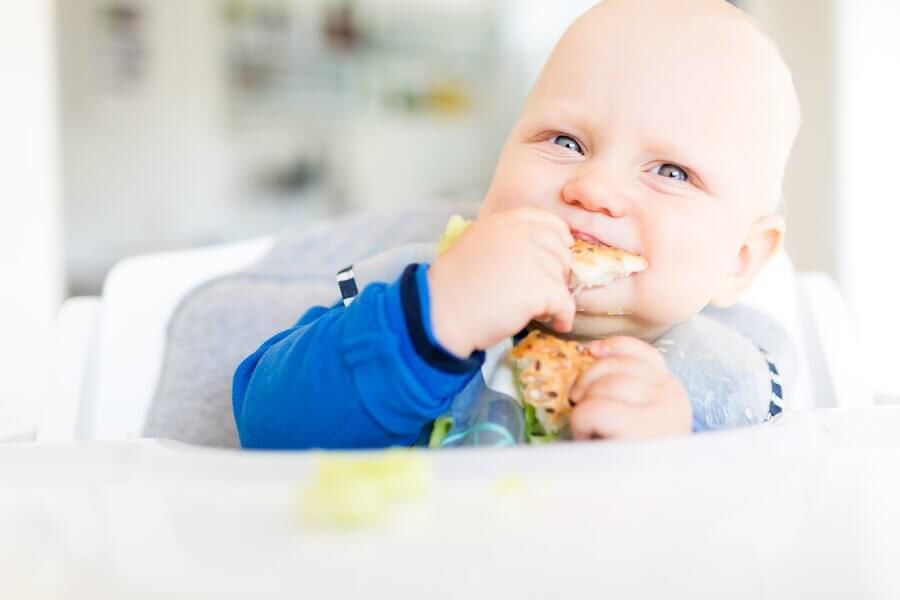How Children Develop Their Food Tastes

As previously said, genes have a lot to do with what we like to eat or not. But it’s not that simple. Food tastes can change and food habits can be acquired over time. Keep reading to learn more about how children develop their food tastes.
How are food tastes developed?
First of all, everything starts in the uterus. During the first 7 to 8 weeks of pregnancy, fetuses develop taste buds. Through the umbilical cord and the amniotic fluid, babies get all their nutrients from their mothers.
Later on, during breastfeeding, babies start to taste what their mothers eat. Like this, when the baby eats something new, he or she prefers those that taste similar to past meals. Repetition also influences this, as do social environments and what babies feel when they eat. Even your culture can determine your food tastes.

The influence of nursing habits in food tastes
Breastmilk has a lot more benefits than baby formulas, but sometimes babies aren’t interested or mothers can’t produce enough. However, studies show that breastmilk makes it easier for babies to try new foods.
Perception of saltiness
This starts to develop naturally at 4 months of age. By 2 years of age, babies usually crave salty foods. Mothers who eat a lot of salty foods during pregnancy, have a higher chance of giving birth to underweight babies. However, you can educate yourself and your baby to have a less salty diet.

Sweet things never made anyone bitter
Children tend to love sweets. Sweet flavors have always been connected with feeling well due to the zones it triggers in our brains. Just a little sugar can increase children’s heartbeat. We know this because of breastmilk’s sweetness.
Sweetness is also associated with parties and celebrations, it gives us a feeling of joy. Maybe that’s why we eat chocolate when we’re feeling down. However, some genes can make this different for some people. Therefore, some people can only consume a little sugar at once.

Things can go sour real quick
Sourness was characteristic of certain green, poisonous, prehistoric fruits. Some people fell ill, and some even died, after eating them. That’s why children can be programmed to hate some foods, like broccoli or Brussel sprouts.
Everybody has receptors on their tongues that are triggered with sweetness or sourness. If your child is sensitive to sugary tastes, then he won’t eat many sweets, for example. Although, after 10 or more tries, he may come around.
As previously said, genes have a lot to do with what we like to eat or not. But it’s not that simple. Food tastes can change and food habits can be acquired over time. Keep reading to learn more about how children develop their food tastes.
How are food tastes developed?
First of all, everything starts in the uterus. During the first 7 to 8 weeks of pregnancy, fetuses develop taste buds. Through the umbilical cord and the amniotic fluid, babies get all their nutrients from their mothers.
Later on, during breastfeeding, babies start to taste what their mothers eat. Like this, when the baby eats something new, he or she prefers those that taste similar to past meals. Repetition also influences this, as do social environments and what babies feel when they eat. Even your culture can determine your food tastes.

The influence of nursing habits in food tastes
Breastmilk has a lot more benefits than baby formulas, but sometimes babies aren’t interested or mothers can’t produce enough. However, studies show that breastmilk makes it easier for babies to try new foods.
Perception of saltiness
This starts to develop naturally at 4 months of age. By 2 years of age, babies usually crave salty foods. Mothers who eat a lot of salty foods during pregnancy, have a higher chance of giving birth to underweight babies. However, you can educate yourself and your baby to have a less salty diet.

Sweet things never made anyone bitter
Children tend to love sweets. Sweet flavors have always been connected with feeling well due to the zones it triggers in our brains. Just a little sugar can increase children’s heartbeat. We know this because of breastmilk’s sweetness.
Sweetness is also associated with parties and celebrations, it gives us a feeling of joy. Maybe that’s why we eat chocolate when we’re feeling down. However, some genes can make this different for some people. Therefore, some people can only consume a little sugar at once.

Things can go sour real quick
Sourness was characteristic of certain green, poisonous, prehistoric fruits. Some people fell ill, and some even died, after eating them. That’s why children can be programmed to hate some foods, like broccoli or Brussel sprouts.
Everybody has receptors on their tongues that are triggered with sweetness or sourness. If your child is sensitive to sugary tastes, then he won’t eat many sweets, for example. Although, after 10 or more tries, he may come around.
All cited sources were thoroughly reviewed by our team to ensure their quality, reliability, currency, and validity. The bibliography of this article was considered reliable and of academic or scientific accuracy.
- Spahn JM, Callahan EH, Spill MK, Wong YP, Benjamin-Neelon SE, Birch L, et al. (2019). Influence of maternal diet on flavor transfer to amniotic fluid and breast matic review. Am J Clinmilk and children’s responses: a syste Nutr. 2019;109(7):1003S-1026S.
- Beauchamp GK, Mennella JA. (2011). Flavor perception in human infants: Development and functional significance. Digestion. 2011;83(SUPPL.1):1–6.
- Mennella JA, Bobowski NK, Reed DR. (2016). The development of sweet taste: From biology to hedonics. Rev Endocr Metab Disord. 2016;17(2):171–8.
- Bobowski NK, Mennella JA. (2016). The sweetness and bitterness of chilhood: insights from basic research on taste preferences, Physiol Behav. 2016;25(3):289–313.
- Duffy VB, Bartoshuk, LM. (2000). Food acceptance and genetic variation in taste. J Am Diet Ass. 2000; 1000(6):647-55.
- Hayes JE, Bartoshuk LM, Kidd JR, Duffy VB. (2008). Supertasting and PROP bitterness depends on more than the TAS2R38 gene. Chem Senses. 2008;33(3):255–65.
- Tepper BJ. (2008). Nutritional Implications of Genetic Taste Variation: The Role of PROP Sensitivity and Other Taste Phenotypes. Annu Rev Nutr. 2008;28(1):367–88.
- Tepper BJ, White EA, Koelliker Y, Lanzara C, D’Adamo P, Gasparini P. (2009). Genetic variation in taste sensitivity to 6-n-propylthiouracil and its relationship to taste perception and food selection. Ann N Y Acad Sci. 2009;1170:126–39.
- Bee Wilson. (2016). El primer bocado: cómo aprendemos a comer. 1ª ed. España: Turner; 2016.
This text is provided for informational purposes only and does not replace consultation with a professional. If in doubt, consult your specialist.








